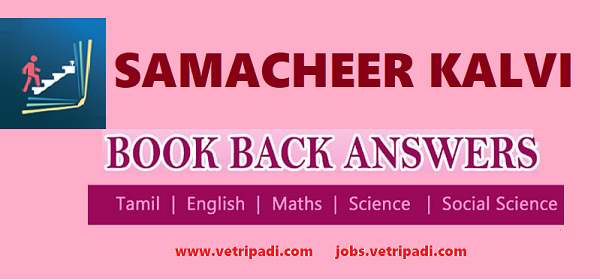8th Social Science – Civics Book Back
& Questions Answers (solution)
Term 3
2. The Judiciary
8th Social Science Civics Solutions Term 3 – Chapter 2 The Judiciary Tamilnadu Samacheer Kalvi – English Medium
I. Choose the best answer:
- The highest and final judicial tribunal of India is-
(a) President
(b) Parliament
(c) Supreme Court
(d) Prime Minister
Answer: (c) Supreme Court
2. Judicial system provides a mechanism for resolving disputes between-
(a) Citizen
(b) Citizen and the government
(c) Two State governments
(d) all the above
Answer: (d) all the above
3. Dispute between States of India comes to the Supreme Court under-
(a) Original jurisdiction
(b) Appellate jurisdiction
(c) Advisory jurisdiction
(d) none of these
Answer: (a) Original jurisdiction
4. Which of the following state/ Union territories have a common High Court?
(a) Punjab and Jammu Kashmir
(b) Assam and Bengal
(c) Panjab, Haryana and Chandigarh
(d) Uttar Pradesh and Bihar
Answer: (c) Panjab, Haryana and Chandigarh
5. The System of Public Interest Litigation has been introduced in India by-
(a) Supreme Court
(b) Parliament
(c) Political parties
(d) Constitutional amendments
Answer: (a) Supreme Court
6. How many courts are there in apex level in India?
(a) One
(b) Two
(c) Three
(d) Four
Answer: (a) One
7. Supreme court is located at-
(a) Chandigarh
(b) Bombay
(c) Calcutta
(d) New Delhi
Answer: (d) New Delhi
8. FIR means-
(a) First Information Report
(b) First information Result
(c) First Incident Report
(d) None of these
Answer: (a) First Information Report
9. The court that hear criminal cases are called-
(a) District court
(b) Sessions court
(c) Family court
(d) Revenue court
Answer: (b) Sessions court
II. Fill in the Blanks:
- The ________High Court is the oldest High Court in India.
- The framers of the Constitution established ________and _______ judiciary in India.
- _______ a famous French philosopher propounded the idea of an independent judiciary.
- ________ deals with disputes over money, property and social matters.
- During ancient times, most of the Kings’ courts dispensed justice according to _______
Answer:
- Calcutta
- independent, impartial
- Montesquieu
- Civil Law
- Dharma
III. Match the following:
- Supreme Court – social duties
- High Court – speedy justice
- Lok Adalat – highest court of appeal
- Sir Elijah Impey – highest court in the States
- Smiritis – chief justice
Answer:
- Supreme Court – highest court of appeal
- High Court – highest court in the States
- Lok Adalat – speedy justice
- Sir Elijah Impey – chief justice
- Smiritis – social duties
IV. State True or False:
- The Supreme Court of India was inaugurated on 28th January 1951.
- During the Tughlaq period, the code of procedure was written in Arabic.
- The Regulating Act of 1773 made provision for the formation of Supreme Court.
- Sadar Diwani Adalat was a Criminal court of appeal.
- The Allahabad High Court is the largest court in India.
- The Constitution of India secures justice to all its citizen.
Answer:
- False
- True
- True
- False
- True
- True
V. Choose the correct statement:
- Consider the following statements.
(i) A law commission was setup by Macaulay.
(ii) It codified the Indian Laws.
Which of the statements given above is / are correct?
(a) (i) only
(b) (ii) only
(c) Both (i) and (ii)
(d) Neither (i) nor (ii)
Answer: (c) Both (i) and (ii)
2. Consider the following statements.
(i) An Indian Penal Code was prepared in 1860.
(ii) The Calcutta High Court was established in 1862.
(iii) The Government of India Act, 1935 created Federal Court.
Which of the statements given above is/are correct?
(a) (i) only
(b) (ii), (iii) only
(c) (i),(iii) only
(d) All the above
Answer: (d) All the above
3. Which of the following statement is not true about India’s Supreme Court?
(i) The Supreme Court of India is the highest court of the land.
(ii) It was established by part V under Chapter IV of Indian Constitution.
(iii) Supreme court cannot transfer cases from one High court to another
(iv) Its decisions are binding on all courts
(a) (i)
(b) (ii)
(c) (iii)
(d) (iv)
Answer: (c) iii
4.Assertion (A): The Supreme Court is a Court of Record.
Reason (R): It maintains records of the court proceedings and its decisions are finding upon the lower courts.
(a) A is correct and R is wrong.
(b) Both A and R are Wrong
(c) A is correct and R explains A
(d) A is correct and R does not explain A
Answer: (c) A is correct and R explains A
5. Agree or disagree
(a) Every citizen of India can approach the Supreme court.
(b) Rich and powerful people control the judiciary system.
(c) Every citizen has a right to get justice through the courts.
(d) Politicians can not control over judges
Answer: We agree with a, c, and d. Disagree with b
VI. Answer the following in one or two sentences:
1. Why do we need judicial system?
Answer:
- Judiciary plays an important role as an organ of the government.
- It administers justice, settles disputes, interprets laws, protects fundamental rights and acts as guardian of the Constitution.
- So we need a judiciary to be efficient in order to ensure proper justice.
2. What are the different levels of courts in India?
Answer:
The different levels of courts in India are
- Subordinate Courts.
- District Courts.
- High Court and
- Supreme Court
3. Differentiate Law and Judiciary.
Answer:
Law:
It is a system of rules imposed through a government or institution to govern people.
Judiciary:
In law, the Judiciary or Judicial system is the system of courts which administers Justice in the name of the State.
4. Write a note on Lok Adalat.
Answer:
- Lok Adalat was set up to provide speedy justice.
- It hears and settles the disputes in the language of the people in the public presence.
- A Lok Adalat is presided over by a retired judge along with a lawyer and a social worker.
- Cases are put forward without advocates.
- The first Lok Adalat was held on 1982 at Junagadh of Gujarat.
5. What are the advantages of mobile courts?
Answer:
- Mobile courts will be of great relief to the rural people.
- It would create greater awareness about the judicial system among the rural masses, cut costs for them and render justice at their doorstep.
VII. Answer the following in detail:
- Write about the role of judiciary.
Answer:
Role of Judiciaiy can be classified as,
1. Dispute Resolution:
Role of Judiciary can be classified as, The Judicial system provides a mechanism for resolving disputes between Citizen, Citizens and the government, Two State governments,the Centre and the State governments
2. Judicial Review:
The Judicial has the power to declare a law unconstitutional if it believes that the law passed by the Parliament is violating the basic structure of the Constitution.
3. Upholding the Law and Enforcing Fundamental Rights:
Every citizen of India can approach the Supreme Court or High Court if they believe that their fundamental rights have been violated
2. Differentiate Civil Law and Criminal Law.
Answer:
Civil Law:
- It deals with disputes over money property and social matters.
Eg. Disputes relating to land, rent, marriage dispute etc., - A petition has to be filed before the relevant court by the affected parties.
- Sentences awarded in the form of money remuneration and as per the petitioner’s claim.
Criminal Law:
- It deals with conducts or acts that the law defines as offences.
Eg. Theft, murder, women harassment etc., - It usually begins with lodging of an FIR (First Information Report) with police investigation after which a case is filed in the court.
- Punishment is awarded if proven guilty, the accused is sent to jail.
3. Descrbe jurisdiction of Suppreme Court.
Answer:
1. Jurisdiction of Supreme Court:
- The Supreme Court can hear dispute for the first time in that court only.
- It is mainly concerned disputes between the Union and one or more states and between two or more states.
2. Appellate Jurisdiction:
It can hear appeals against the decisions made by the High Court on the granting of certificate by the High Court.
3. Advisory Jurisdiction: The Court can report to the President its opinion about a question of the public importance referred to it by the President.
4. Writs Jurisdiction:
The Writs are issued by the Supreme Court under Article 32 and by the High Courts under Article 226 of the Constitution of India.
5. Court of Record:
it maintains records of the court proceedings and its decisions are finding upon the lower courts.
6. Special Powers:
it supervises the functioning of the lower courts.
VIII. Project and Activity:
- Discuss: Is it necessary to have an independent judiciary? List two reasons.
Answer:
Activity to be done by the students
2. Organize your classroom for a lockup courtroom session. (Take a case with the help of the teacher)
Answer:
Activity to be done by the students
Tags:
8th social guide samacheer kalvi,samacheer kalvi 8th books guide social science,social guide for 8th standard samacheer kalvi,samacheer kalvi guru 8th social guide,8th standard social guide samacheer kalvi,samacheer kalvi 8th social guide pdf,8th social guide tamil medium samacheer kalvi,8th social guide tamil medium samacheer kalvi,samacheer kalvi 8th books guide social science,samacheer kalvi guru 8th social guide,samacheer kalvi 8th social guide pdf,8th standard social guide samacheer kalvi,8th social guide tamil medium samacheer kalvi,8th social guide tamil medium samacheer kalvi,social guide for 8th standard samacheer kalvi,samacheer kalvi 8th books guide social science,samacheer kalvi guru 8th social guide,social guide for 8th standard samacheer kalvi,samacheer kalvi 8th social guide pdf,8th standard social guide samacheer kalvi,samacheer kalvi 8th books guide social science,samacheer kalvi guru 8th social guide,social guide for 8th standard samacheer kalvi,8th social guide tamil medium samacheer kalvi,8th standard social guide samacheer kalvi,8th social guide tamil medium samacheer kalvi,samacheer kalvi 8th social guide pdf,samacheer kalvi 8th books guide social science,social guide for 8th standard samacheer kalvi,samacheer kalvi guru 8th social guide,8th social guide tamil medium samacheer kalvi,8th standard social guide samacheer kalvi,samacheer kalvi 8th social guide pdf,8th social guide tamil medium samacheer kalvi,samacheer kalvi 8th books guide social science,social guide for 8th standard samacheer kalvi,samacheer kalvi guru 8th social guide,8th social guide tamil medium samacheer kalvi,8th social guide tamil medium samacheer kalvi,samacheer kalvi 8th social guide pdf,8th standard social guide samacheer kalvi,samacheer kalvi 8th books guide social science,samacheer kalvi guru 8th social guide,social guide for 8th standard samacheer kalvi,samacheer kalvi 8th social guide pdf,8th standard social guide samacheer kalvi,8th social guide tamil medium samacheer kalvi,samacheer kalvi 8th books guide social science,social guide for 8th standard samacheer kalvi,samacheer kalvi guru 8th social guide,8th social guide tamil medium samacheer kalvi,8th standard social guide samacheer kalvi,samacheer kalvi 8th social guide pdf,8th social guide tamil medium samacheer kalvi,


